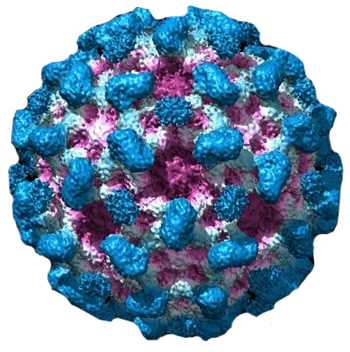BACKGROUND
Hepatitis E is a liver disease caused by the hepatitis E virus. The hepatitis E virus is transmitted mainly through contaminated drinking water.
Most people with hepatitis E get better within a few months. Usually it doesn’t lead to long-term illness or liver damage like some other forms of hepatitis do. But hepatitis E can be dangerous for pregnant women or anyone with weak immune systems, including the elderly or people who are ill.
DISEASE OCCURRENCE IN POPULATION
The World Health Organization (WHO) estimates that hepatitis E virus (HEV) causes 20 million new infections annually, with more than 3 million cases of acute hepatitis and over 55,000 deaths. HEV infection has a global distribution. Specific genotypes result in infection in different geographic areas

- Genotypes 1 and 2 have been reported mainly in Asia, India, and North Africa.
- Genotype 2 has been identified in Mexico and West Africa.
- Genotype 3 is prevalent in Western countries, as well as in Asia and North America.
- Genotype 4 has been detected in Asian and European countries.
RISK FACTORS
The hepatitis E virus spreads through poop. You can catch it if you drink or eat something that has been in contact with the stool of someone who has the virus. Hepatitis E is more common in parts of the world with poor handwashing habits and lack of clean water.
You also can get hepatitis E if you eat undercooked meat from infected animals, such as pigs or deer. Less often, you can get the virus from raw shellfish that comes from tainted water.
SIGN AND SYMPTOMS
- Mild fever
- Feeling very tired
- Less hunger
- Feeling sick to your stomach
- Throwing up
- Belly pain
- Dark pee
- Light-colored poop
- Skin rash or itching
- Joint pain
- Yellowish skin or eyes
DIAGNOSTIC TESTS
Your doctor will ask for your medical history and details about your symptoms. Tell your doctor about any recent travel. Tell them if you think you might have had contact with water contaminated by sewage.
Your doctor will use a blood test or a stool test to diagnose hepatitis E.
TREATMENT OPTIONS
In most cases, hepatitis E goes away on its own in about 4-6 weeks. These steps can help ease your symptoms:
- Rest
- Eat healthy foods
- Drink lots of water
- Avoid alcohol
Check with your doctor before you take any medicine that may damage your liver, such as acetaminophen.
If you’re pregnant, your doctor may keep you under watch in the hospital. If your condition is serious, you may get medicine to fight the infection.
PRECAUTIONS
- Hepatitis E is preventable by vaccination.
- Patients should use clean drinking water, good sanitation, and proper personal hygiene.
- Travelers to endemic areas should avoid drinking water or other beverages that may be contaminated
- Should avoid eating uncooked shellfish.
- Care should be taken in the preparation of uncooked fruits or vegetables.
- Boiling water may prevent infection, but the effectiveness of chlorination is unknown.
- Wash your hands with soap and water after you use the bathroom, change a diaper, and before you prepare or eat food.
REFERENCES
- World Health Organization. Hepatitis E Fact sheet (updated July 2016). http://www.who.int/mediacentre/factsheets/fs280/en/ (Accessed on November 28, 2018).
- Balayan MS, Andjaparidze AG, Savinskaya SS, et al. Evidence for a virus in non-A, non-B hepatitis transmitted via the fecal-oral route. Intervirology 1983; 20:23
- Khuroo MS. Study of an epidemic of non-A, non-B hepatitis. Possibility of another human hepatitis virus distinct from post-transfusion non-A, non-B type. Am J Med 1980; 68:818.
- Meng XJ, Wiseman B, Elvinger F, et al. Prevalence of antibodies to hepatitis E virus in veterinarians working with swine and in normal blood donors in the United States and other countries. J Clin Microbiol 2002; 40:117.
- Thomas DL, Yarbough PO, Vlahov D, et al. Seroreactivity to hepatitis E virus in areas where the disease is not endemic. J Clin Microbiol 1997; 35:1244.
- Kuniholm MH, Purcell RH, McQuillan GM, et al. Epidemiology of hepatitis E virus in the United States: results from the Third National Health and Nutrition Examination Survey, 1988-1994. J Infect Dis 2009; 200:48.
- Tang YW, Wang JX, Xu ZY, et al. A serologically confirmed, case-control study, of a large outbreak of hepatitis A in China, associated with consumption of clams. Epidemiol Infect 1991; 107:651.
- Quintana A, Sanchez L, Larralde O, Anderson D. Prevalence of antibodies to hepatitis E virus in residents of a district in Havana, Cuba. J Med Virol 2005; 76:69.
- Lynch M, O’Flynn N, Cryan B, et al. Hepatitis E in Ireland. Eur J Clin Microbiol Infect Dis 1995; 14:1109.
- Sylvan SP. The high rate of antibodies to hepatitis E virus in young, intravenous drug-abusers with acute hepatitis B-virus infection in a Swedish community: a study of hepatitis markers in individuals with intravenously or sexually acquired hepatitis B-virus infection. Scand J Infect Dis 1998; 30:429.
- Christensen PB, Engle RE, Jacobsen SE, et al. High prevalence of hepatitis E antibodies among Danish prisoners and drug users. J Med Virol 2002; 66:49.
- Ibarra HV, Riedemann SG, Siegel FG, et al. Hepatitis E virus in Chile. Lancet 1994; 344:1501.
- Banks M, Bendall R, Grierson S, et al. Human and porcine hepatitis E virus strains, United Kingdom. Emerg Infect Dis 2004; 10:953.
- Stefanidis I, Zervou EK, Rizos C, et al. Hepatitis E virus antibodies in hemodialysis patients: an epidemiological survey in central Greece. Int J Artif Organs 2004; 27:842.
- Gessoni G, Manoni F. Hepatitis E virus infection in north-east Italy: serological study in the open population and groups at risk. J Viral Hepat 1996; 3:197.
- Clemente-Casares P, Pina S, Buti M, et al. Hepatitis E virus epidemiology in industrialized countries. Emerg Infect Dis 2003; 9:448.
